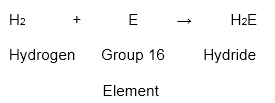Anomalous Properties Of Oxygen
Anomalous Properties of Oxygen
Oxygen is the first element of Group 16 in the p block. It is the first group in the p block which has no stable metallic elements. Oxygen is an essential component in the combustion processes. It is one of the most plenteous elements in the earth's crust.
Anomalous Behaviour of Oxygen
Oxygen differs broadly from the rest of the elements of group 16. This is because of its smaller size, high electronegativity and the no vacant d-orbitals in the valence shell. The basic complexities are:
Atomicity:
Oxygen exists in the gaseous phase, and diatomic essentially, whereas all other elements of this group exist as solids.
Highest Covalency:
Oxygen covalency is limited to 2, but the covalency surpasses 4 in other elements of group 16 because of the presence of d-orbitals in them.
Formation of M – 2 ions:
Owing to its high electronegativity, oxygen exhibits a negative oxidation state and does not show any positive oxidation state, except in the case of OF2 and O2F2.
Hydrogen Bond Formation:
Because of its small size and high electronegativity, oxygen forms strong hydrogen bonds. Other group 16 elements have moderately low electro-negativities and don't form hydrogen bonds.
Oxygen Oxidation State:
The general oxidation state for oxygen (O) is -2, but oxygen also has +2 oxidation state, in the case of OF2. However, the oxygen oxidation state is +1 in O2F2 the oxidation state is +1. The oxidation state of oxygen is in +ve because oxygen is less electronegative than fluorine.
Physical Properties of Oxygen
Oxygen exist in the gaseous phase. It is colourless, odourless in a typical state. Liquid oxygen is slightly paramagnetic in nature. It is reactive and forms oxides with each component aside from helium, krypton, neon, and argon. It is moderately soluble in water. Oxygen has two allotropes, namely dioxygen and ozone.
Group 16 Elements Physical and Chemical Properties.
The members of the Group 16 are:
- Oxygen (O)
- Sulphur (S)
- Selenium (Se)
- Tellurium(Te)
- Polonium (Po)
Related Videos:
- Anomalous Properties Of Nitrogen
- Anomalous Properties Of Fluorine
- Anomalous Behaviour Of Carbon
- Examples to show the anomalous behaviour of fluorine
These elements oxygen, sulfur, selenium, tellurium and polonium makes the 16th vertical column or VIA group elements of the periodic table.
Group 16 Physical Properties
Here we will look at some of the physical characteristics of group 16 elements.
1. The general electronic configuration of group 16 members is ns2 np4
Electronic configurations of each group 16 elements:
Oxygen à [He]2s2,2p4
Sulphur à [Ne]3s2,3p4
Selenium à[Ar]3d104s24p4
Tellurium à[Kr]4d10,5s2,5p4
Polonium à [Xe]4f14,5d10,6s2,6p4
2. Atomic size: The atomic size of group 16 elements increases on moving down the group due to the addition of a new electronic shell. The size of group 16 elements is smaller than that of group 15 elements because of the high nuclear charge
3. Ionization energy The ionization energy of group 16 elements has lower energy than group 15 elements. It is because of half-filled electronic configurations of group 15, which is ns2np3.
As we descend in group 16, the ionization energy decreases because the size increases down the group.
4. Electronegativity: Unlike Ionisation energy, here the group 16 elements electronegativity is higher than group 15 elements. It is because of the small size of the group 16 elements. Group 16 has second-highest electronegativity in the entire periodic table. Oxygen is the second most electronegative element in the periodic table.
On moving down the group 16, the electronegativity of the element decreases as size increases.
5. Electron gain enthalpy
Along period it is more negative because of attraction towards electron because of increased nuclear charge.
Down the group electron gain enthalpy keeps on becoming less negative because of the decrease in the nuclear charge, and an increase in the atomic size.
The trend that was anticipated
O>S>Se>Te (wrong trend)
O<S>Se>Te (right trend)
Oxygen has less electron gain enthalpy than sulphur because due to the small size of oxygen, the incoming electron suffers repulsion; therefore, electron gain enthalpy is less negative as compared to sulphur.
6. Oxidation states: The group 16 elements generally exhibit -2 oxidation state.
For sulphur: The oxidation states exhibited by sulphur are +2, +4, +6. It is due to the empty d orbital. The oxidation state of sulphur is +4 in SO2, and in H2S, it shows oxidation state of -2. In sulphuric acid, the oxidation state of sulphur is +6.
Down the group the vacant d orbital are present; therefore, they all can show +2, +4, +6 oxidation states.
7. Melting and Boiling Points
With the increase in the atomic size in group 16, i.e oxygen à telleurium, the melting and boiling points of the group 16 members also increase.
The large difference between the melting and boiling points of oxygen and sulphur is because of the fact that oxygen exists as a diatomic atom, while sulphur exists as the polyatomic particle, S8.
Chalcogen Group
The first four elements of group 16 are collectively termed as chalcogens as they form ores. Since a large number of metal ores are found in the earth's crust as oxides or sulfides.
Elemental structure of oxygen and sulphur
Oxygen occurs as the diatomic gas, whereas sulphur exists as S8 in solid form in a puckered ring structure as depicted below:

The pπ-pπ bonding occur in oxygen, but no such bonding takes place in the case of sulphur . It is the reason oxygen exist as gas and sulphur exist as solid.
Sulphur exist as many allotropic forms but only two of them are stable including rhombic sulphur and monoclinic sulphur.
Group 16 Chemical Properties
Order of Reactivity:
Group 16 elements reactivity order is:
Oxygen > Sulphur > Selenium > Tellurium
Oxygen is highly reactive, and the reactivity decreases on moving down the group 16.
Most of the reactions of oxygen are exothermic reactions; therefore, the reactions are called combustion reaction.
Reaction with hydrogen
On reaction with hydrogen, the group 16 elements form hydrides with general formula H2E, where E could be any element oxygen, sulphur, selenium, tellurium or polonium.

Reaction with halogen: Group 16 elements react with halogen to form halides of formula EX4, EX6 and EX2.
The order of stability of halides are F>Cl>Br>I.
Important Chapters:


Similar Questions
Knowledge Check
Nitrogen differs from rest of the members on the account of various factors. Which of the following properties can be classified as anomalous properties of nitrogen ?
ABond enthalpy of N≡N is 941.4 kJ/molBHydride of nitrogen i.e., amonia has apperciable boiling point as compared to the other members like P, As.CNH3 can form unstable complexes by donating its lone pairDMolecular nitrogen comprises 78% by volume of the atmosphereWhich of the following does not illustrate the anomalous properties of Li?
AThe m.pt. and b.pt. of Li are comparatively high.BLi forms a nitride Li3N unlike group 1 metals.CLi is much softer than the other group 1 metals.DLi+ ion and its compounds are more heavily hydrated than those of the rest of the group
Anomalous Properties Of Boron
View SolutionAnomalous Properties Of Nitrogen
View SolutionAnomalous Properties Of Nitrogen|What Is Disproportionation Reaction?|Reactivity Towards Hydrogen|Dinitrogen|Ammonia|Nitric Acid|Brown Ring Test|Summary
View SolutionAnomalous Properties Of Fluorine
View SolutionGroup 1|Anomalous Properties Of Lithium|Points Of Difference Between Lithium And Other Alkali Metals|Sodium Carbonate (Washing Soda) Na2CO3.10H20|Questions|Properties|Function Of Ammonia
View SolutionMention any two anomalous properties of second period elements.
View Solution
